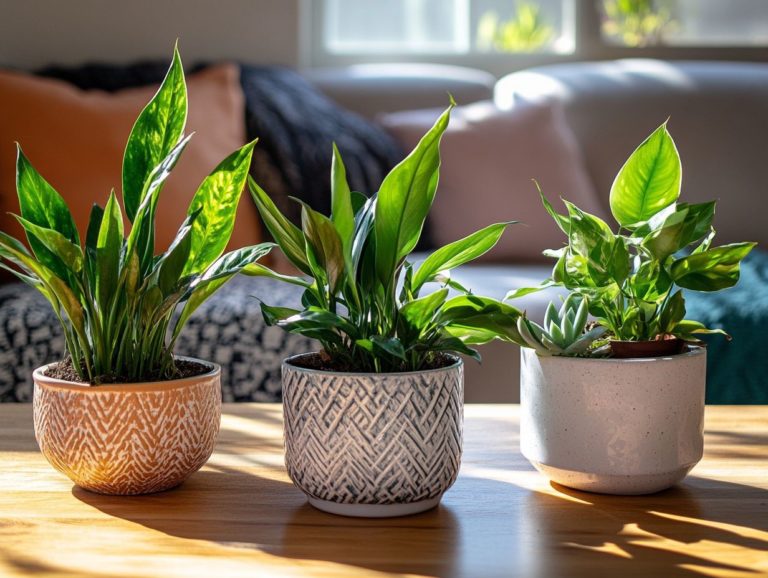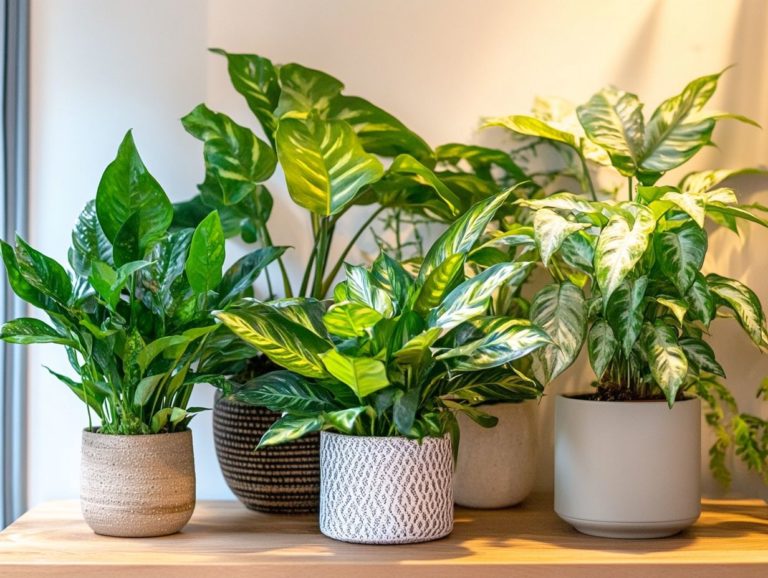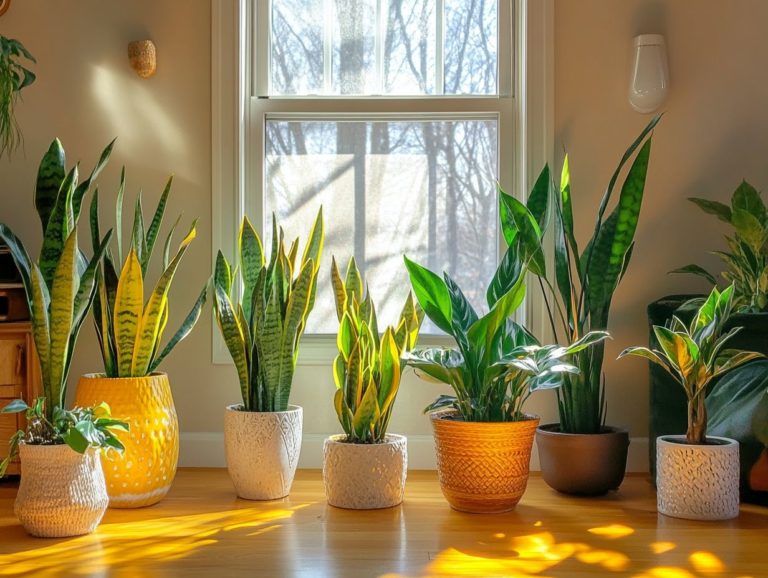Caring for Indoor Peperomias: A Guide
Peperomias are a captivating and varied collection of houseplants, renowned for their distinctive foliage and easy-going demeanor.
This guide equips you with all the essential knowledge to ensure these delightful plants thrive in your home. Get ready to discover exciting insights that will help your Peperomias thrive! From selecting the ideal environment and mastering watering techniques to identifying common pests and mastering the art of repotting, you ll uncover valuable tips throughout.
Whether you re a seasoned plant enthusiast or just beginning your journey, this article will empower you to cultivate a flourishing collection of Peperomias.
Contents
Key Takeaways:
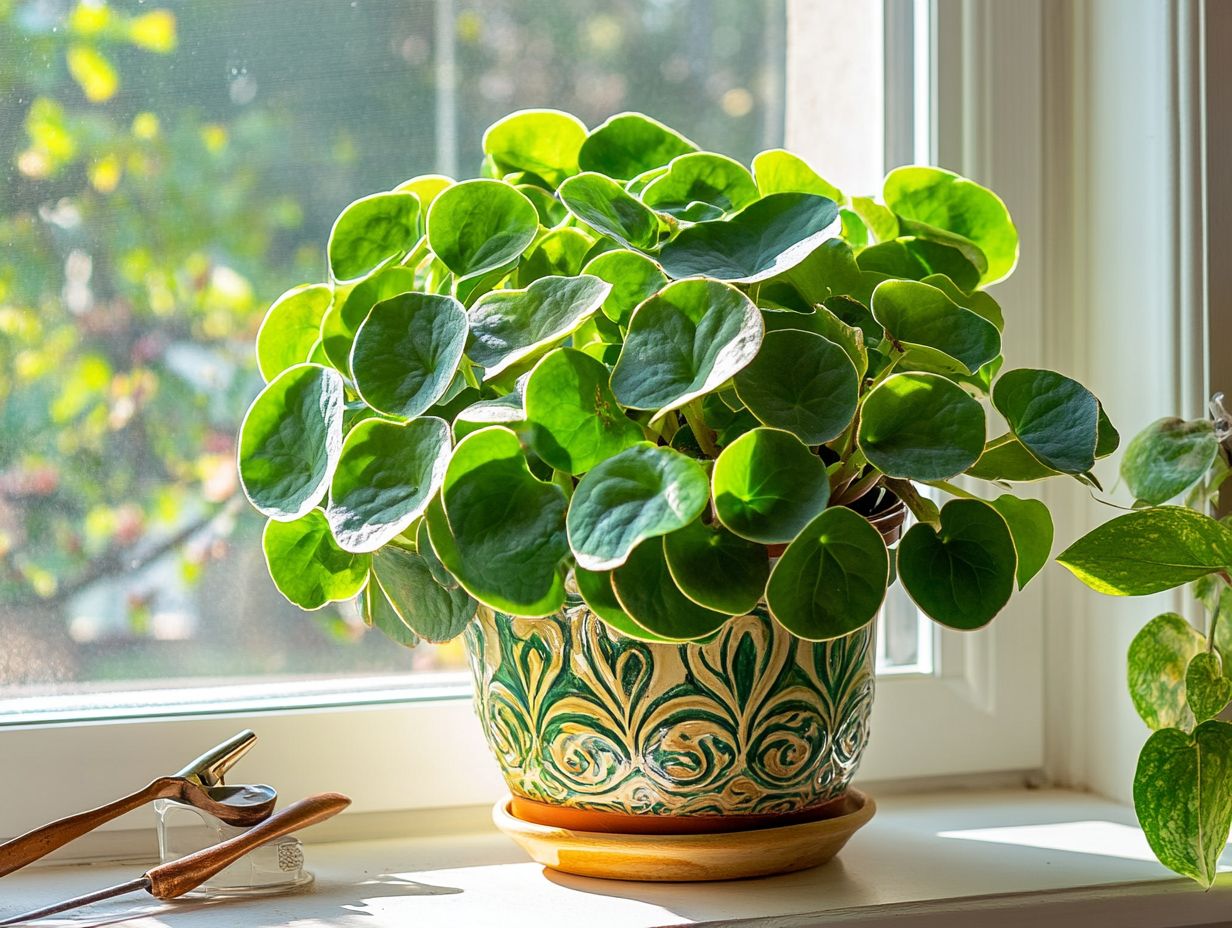
- Proper environment is essential for indoor Peperomias. Choose a bright location with moderate humidity and temperatures to keep them happy and healthy.
- Overwatering is the most common mistake when caring for Peperomias. Water them sparingly and fertilize them regularly for optimal growth and beautiful foliage.
- Keep an eye out for pests and diseases, such as mealybugs and root rot. Early identification and treatment are crucial for maintaining the health of your Peperomias.
Overview of Peperomias and their Varieties
Peperomias are a captivating collection of tropical houseplants native to Central America, celebrated for their compact growth and striking foliage. With a plethora of varieties at your fingertips like Peperomia argyreia, Peperomia obtusifolia, and Peperomia prostrata each one brings its own unique leaf patterns and care requirements.
Take the Peperomia argyreia, for instance, often affectionately dubbed the Watermelon Peperomia. Its uniquely patterned leaves thrive in bright, indirect light and prefer to dry out between waterings. This makes it a delightful addition to your plant collection.
Then there’s Peperomia obtusifolia, with its thick, glossy leaves. This variety is incredibly forgiving, making it a fantastic choice for those who are just starting their plant journey.
On the other hand, if you’re drawn to trailing plants, the Peperomia prostrata, or String of Turtles, demands a touch more humidity to truly flourish.
You can rest easy knowing that all these Peperomias are non-toxic and pet-friendly. This allows you to enjoy them around children and furry companions without a second thought. They truly solidify their status as ideal indoor companions.
Choosing the Right Environment for Peperomias
To cultivate the perfect environment for your Peperomias, it’s essential to grasp their specific needs regarding light, temperature, and humidity. These factors play a crucial role in their growth and vitality, directly impacting their aesthetic charm as indoor plants.
By adjusting these factors, you can ensure your Peperomias thrive and enhance the beauty of your living space.
Light, Temperature, and Humidity Requirements
Peperomias flourish in indirect light and thrive within a stable room temperature, ideally between 65 F to 80 F (18 C to 27 C). They also appreciate medium humidity, which helps them showcase vibrant foliage and robust growth.
These tropical beauties prefer an environment where the light is gentle, allowing their textured leaves to soak up just the right amount of energy without wilting. Temperature fluctuations can stress them, so maintaining consistent warmth is key.
Humidity is equally essential; too little can lead to dry leaf tips, while excessive moisture might invite root rot.
For different Peperomia varieties, adjusting their conditions means placing them in bright, filtered light. You might also consider using a humidifier or a pebble tray to keep those moisture levels just right. Understanding how these factors interact is vital for nurturing lush, healthy growth. Additionally, learning how to propagate Peperomia plants can further enhance your plant care skills.
Watering and Fertilizing Peperomias
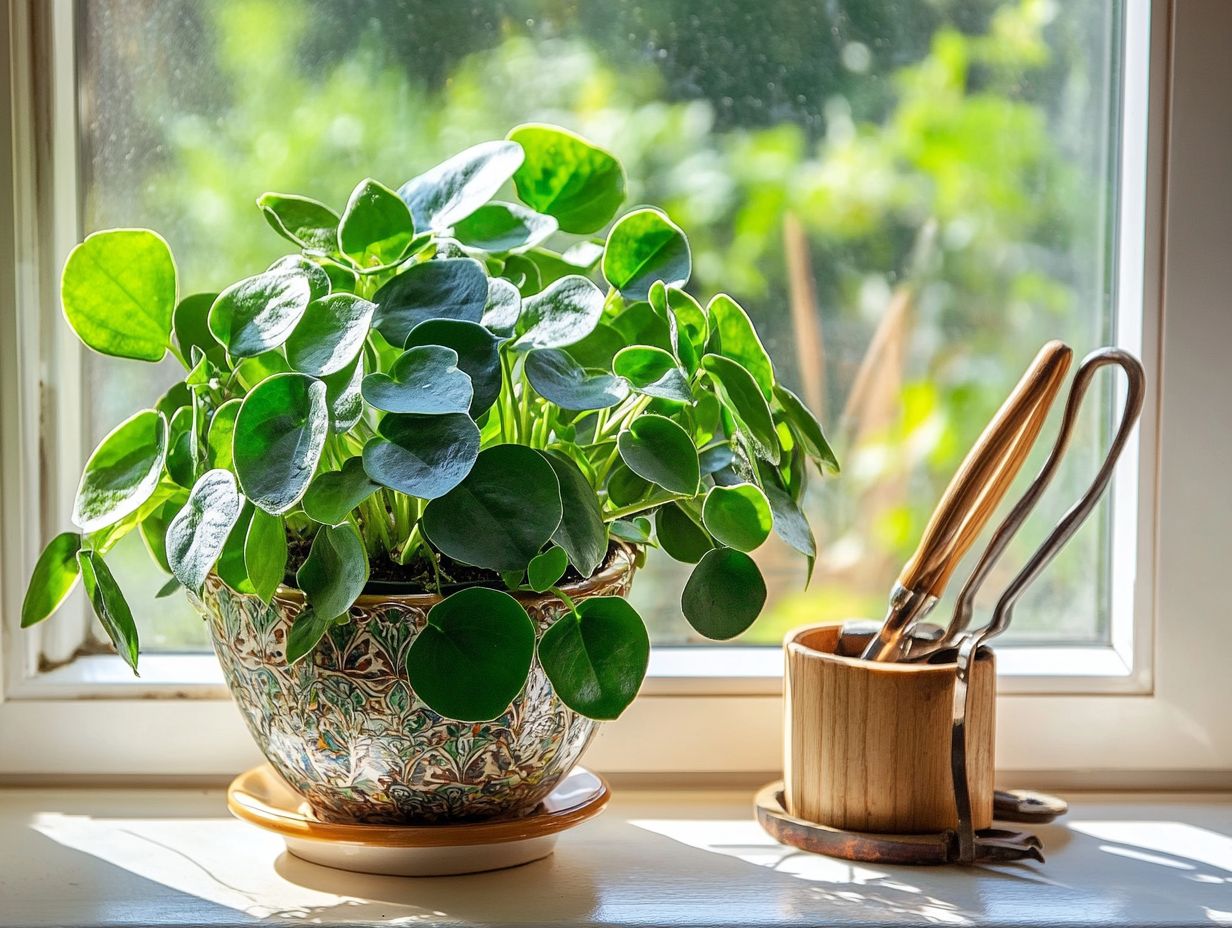
Proper watering and fertilizing techniques are essential for your Peperomias. Establishing an accurate watering schedule tailored to the potting soil’s drainage capabilities (the ability of soil to let water pass through) will significantly reduce the risk of problems like root rot and yellowing leaves.
By ensuring your plants receive just the right amount of moisture, you’ll cultivate a thriving environment for them to flourish.
Don’t miss out on these essential tips that can take your plant care to the next level! Start implementing what you ve learned today and share your experiences with fellow plant lovers.
Proper Techniques and Schedules
Understanding the right techniques for watering and fertilizing your Peperomias means grasping their unique needs, using a well-draining potting mix, and applying fertilizers thoughtfully during the growing season.
Check the top inch of the soil. If it’s dry, give your plant a drink! By regularly checking the soil moisture, you can ensure your plants receive just the right amount of hydration without risking root rot, a condition caused by too much water, leading to root decay. Choosing a balanced fertilizer designed for indoor plants can significantly elevate their growth and overall foliage health.
Consistently applying it during spring and summer provides essential nutrients, resulting in lush, green leaves and a vibrant look. By incorporating these practices, you will cultivate thriving Peperomias with robust health that will be the envy of any plant lover.
Common Pests and Diseases in Peperomias
Understanding the common pests and diseases that can affect Peperomias is crucial for preserving their health. Issues like leaf drop, yellowing leaves, and root rot can severely diminish their aesthetic appeal and vitality.
By staying informed, you can ensure your Peperomias thrive beautifully.
Identification and Treatment
Regarding identifying pests and diseases in your Peperomias, pay close attention to symptoms like yellowing leaves or unusual spots. These signs can guide you in selecting the right treatment to restore your plant s health and vitality.
You should monitor for curling leaves, wilting, and stunted growth; these can hint at underlying issues. Monitoring the environment is crucial, along with checking for pests like spider mites or mealybugs.
For treatment, you might consider using neem oil or insecticidal soap for those pesky invaders, while addressing diseases like root rot may mean changing your watering habits and possibly repotting.
Implementing preventive measures like regular pruning to enhance airflow and ensuring good drainage during propagation can significantly boost your plant s overall health, fostering lush growth and resilience against potential threats.
Repotting and Pruning Peperomias
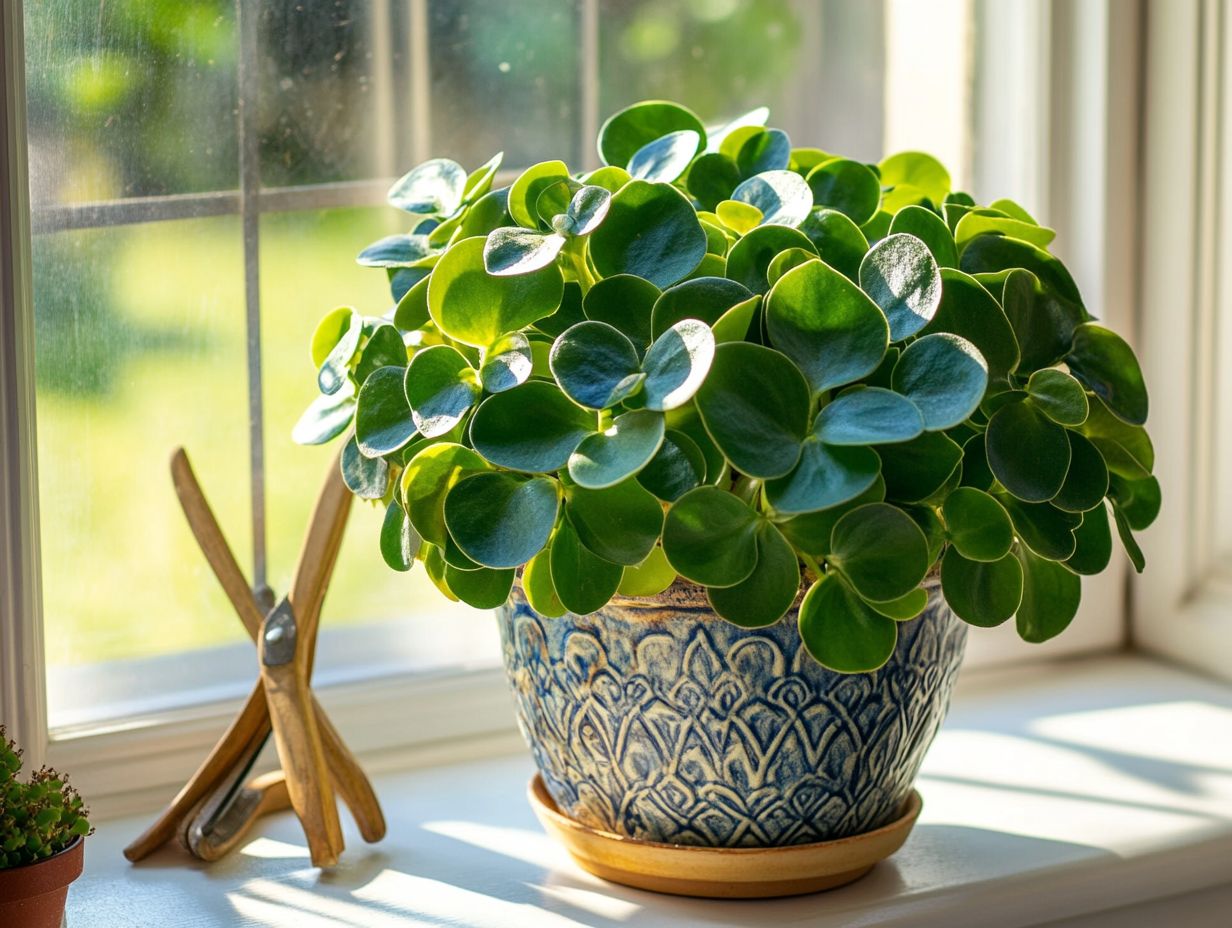
Repotting and pruning are essential practices for ensuring your Peperomias thrive. By engaging in these processes, you enhance air circulation, facilitate growth, and cultivate bushier foliage.
This creates the ideal conditions for new cuttings and roots to flourish, ultimately leading to a more vibrant plant.
Best Practices for Maintaining Healthy Plants
To keep your Peperomias thriving, embrace best practices like timely repotting, effective pruning, and suitable propagation methods to foster new plants while supporting overall growth.
Repot your plants every 1-2 years to keep them healthy and thriving! Fresh soil is essential for maintaining vitality. Pruning is another key aspect; by trimming back leggy stems, you encourage bushier growth, ensuring your plant maintains a well-shaped silhouette while enhancing air circulation.
For propagation, consider techniques like leaf cuttings or division. Not only do these methods expand your collection, but they also rejuvenate the parent plant. Additionally, caring for indoor petunias contributes significantly to the overall health of your Peperomias, making them resilient and vibrant additions to any indoor space.
Troubleshooting Common Issues
Troubleshooting the common issues that Peperomias encounter involves pinpointing specific problems like yellowing leaves, overwatering, and temperature fluctuations.
By addressing these concerns, you can implement effective solutions that ensure your plants flourish beautifully.
Tips for Dealing with Common Problems
Dealing with common issues in your Peperomias starts with recognizing symptoms like leaf dropping and root rot. This awareness allows you to intervene promptly, helping to restore the plant’s health and vigor.
By regularly assessing the environment, you can adapt your watering schedule to keep the soil slightly moist without risking excess water. Too much water can lead to root rot. Adjust the lighting conditions to provide bright, indirect light instead of harsh direct sunlight to prevent leaf scorching and encourage lush growth.
Implement preventive measures, such as using well-draining soil and letting the top inch of soil dry out between waterings. These steps can significantly reduce the chances of common problems. Caring for your Peperomias can make them thrive!
Frequently Asked Questions

What is a Peperomia plant?
A Peperomia plant is a type of houseplant that belongs to the Piperaceae family. It is known for its thick, fleshy leaves and variety of colors and patterns. Peperomias are commonly used as indoor plants due to their low maintenance and compact size. These tropical plants are also safe for pets.
How do I care for my Indoor Peperomia?
To care for your indoor Peperomia, place it in a bright location with indirect light. Water it regularly, but be careful not to over-water as it can cause root rot. Peperomias prefer warmer temperatures, medium humidity, and high moisture, so misting the leaves can be helpful.
What type of potting mix should I use for my Peperomia?
Peperomias require well-draining soil to thrive. A mixture of potting soil, perlite, and peat moss is ideal. Ensure the pot has drainage holes to prevent water from pooling at the bottom, as this can lead to root rot and yellowing leaves.
How often should I fertilize my Indoor Peperomia?
Peperomias do not require frequent fertilization, and too much fertilizer can harm the plant. Fertilize once every 2-3 months during the growing season with a balanced liquid fertilizer, diluted to half strength, to ensure healthy growth.
What are some common pests that affect Peperomias?
The most common pests for Peperomias are mealybugs, aphids, and spider mites. Check for signs of these pests, such as white, fuzzy patches or webs on the leaves. If you notice any, treat the plant with a natural insecticide. Regular pest control can help prevent diseases.
Can I propagate my Peperomia plant?
Yes, Peperomias are easy to propagate through stem cuttings. Simply cut a stem just below a leaf node, remove the bottom leaves, and place the stem in water or well-draining soil. The cutting should root within a few weeks and can be transferred to a larger pot once it has grown roots.
Start caring for your Peperomias today or share your own tips in the comments!


